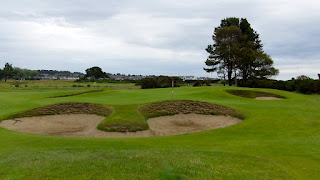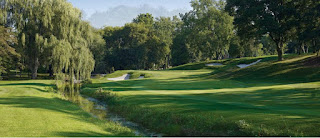
(view of #1 and #18 from #2 / #17 fairway)
If you haven't been fortunate enough to play a round at "the Old," you simply have to go. As my father so eloquently stated at one point during my childhood, in reference to Carmel, CA, "Go early. That way you can go often."
Truer words have never been spoken when applied to St Andrews and the Old Course. It is an amazing place. Nowhere in golf is a town so synonymous with golf. You can feel the history and tradition surrounding you. I can't remember the last time I was nervous for a non-tournament round of golf, but on the first tee of the Old, you can't help but feel a little overwhelmed. The aura of the place simply overtakes you. If it doesn't, you're not appreciating where you are.
Upon first glance, the Old Course is one of the weirdest looking places in golf. For the first time visitor, the 1st and 18th holes are quite simply, very odd. But the more you experience it, the better it gets. The experience of being in St Andrews. The experience of "out" and "in." The experience of the weather - especially the wind. The experience of putting from everywhere because a flop shot is worthless. Links golf is in part, about handling the elements, and simply put, the Old is links golf at it's finest.
My first time in St Andrews was with my Dad. We went for my 16th birthday. Most kids get their license, I got a trip to Scotland. (Yes, I know how lucky I am.) Anyways, I remember my initial frustration with the links style game. The first time around the hallowed links is just simply confusing. Lob shot? No chance. The ball bouncing every which direction? Standard. Drives going 350 downwind and 150 into the wind? The norm. It was madness. Blind shots, criss-crossing holes, drivable par 4's, humps and bumps abound (see picture below). Take all "stock shots" you think you have and throw them in the garbage. Creativity is the name of the game in links golf, and that is why it is so great. You're not forced to play one style of shot.
Some golfers say the Old is outdated, quirky and confusing. These people either a) played it once, or b) are not intelligent. The course was built by nature and maintained by rabbits for many years! What do you expect? A traditional golf course? True, it is worth playing at least two rounds at the Old so you can become comfortable with the lines and where you are going. Only then can you begin to understand the nuances and strategy of this great course. Playing it once does not do it justice. (Full disclosure, I lived in St Andrews for the past year as a post grad student at the University of St Andrews. So I am a bit biased regarding the Old. I played it roughly 40 times and it only got better every time.)
(The walk up to #11 green, one of the greatest par 3's anywhere. Dr. Alister MacKenzie's favourite par 3 on the planet.)
One final note is how the game is viewed in St Andrews. It is completely class-less. Everyone plays golf. It is one's birthright as a St Andrean. The town owns the links and one of the perks of being a resident in St Andrews is remarkable access to the seven courses of the St Andrews Links Trust. Here is the skinny of the deal. As a resident - yes, this includes students - you pay £170 pounds for an annual "links ticket." I paid more for one month dues back home. Oh, and up to the age of 18, St Andreans play all seven courses in town for FREE. Yes, you read that correctly, FREE. This is a true testament not only to what golf means in this town, but how golf should be. Community oriented, open to all, and most of all, affordable.
David Feherty was once quoted as saying that the Old is his favourite Open venue and that "...it is so incredibly beautiful when the shadows hit the swales and hollows." It is so true. My brother-in-law commented on the picture below that he thought it was the pearly gates. This coming from a guy who isn't even a "golfer." Remember, go early, that way you can go often.
Hit 'em well
-MG
(view down #1 and #18)















